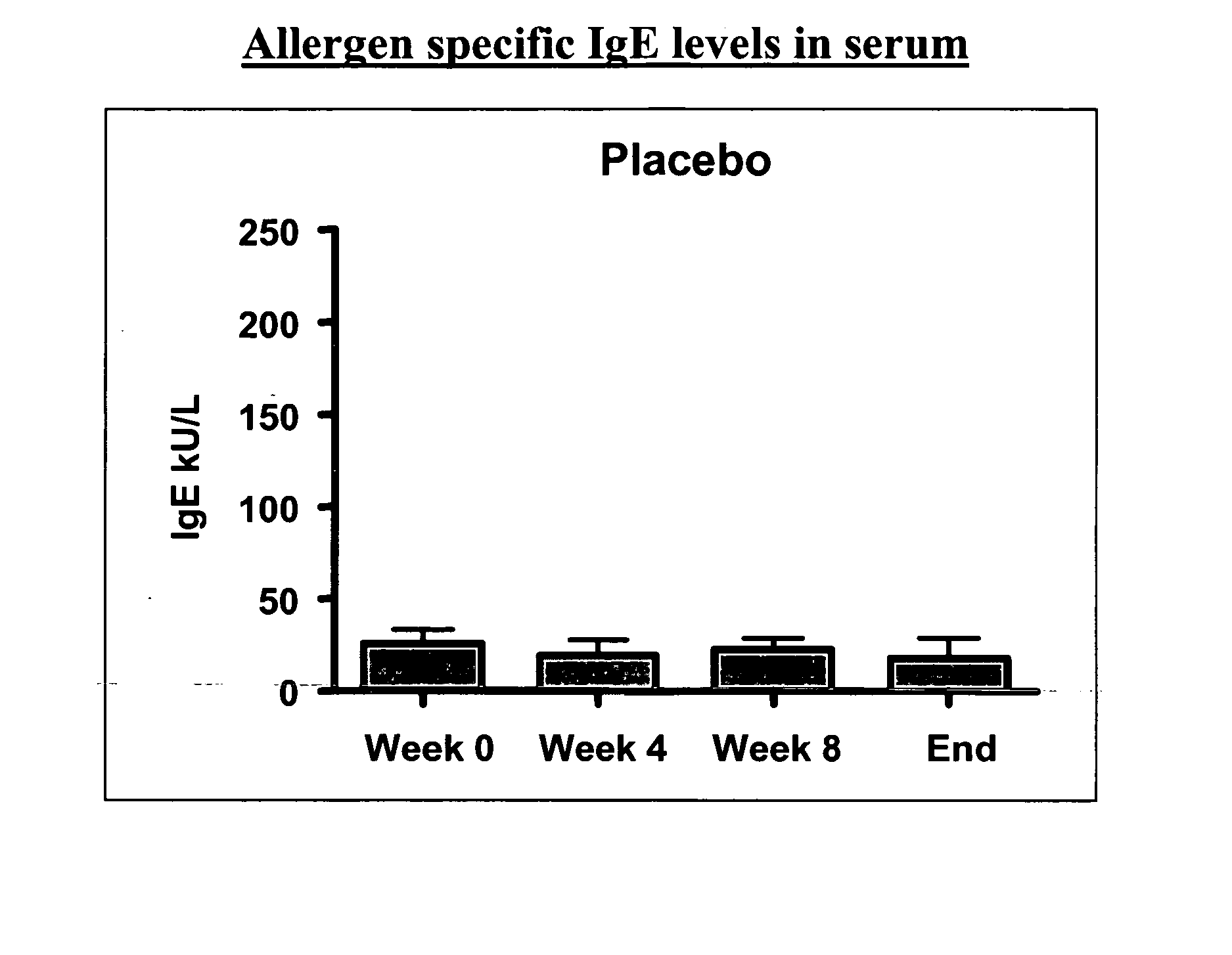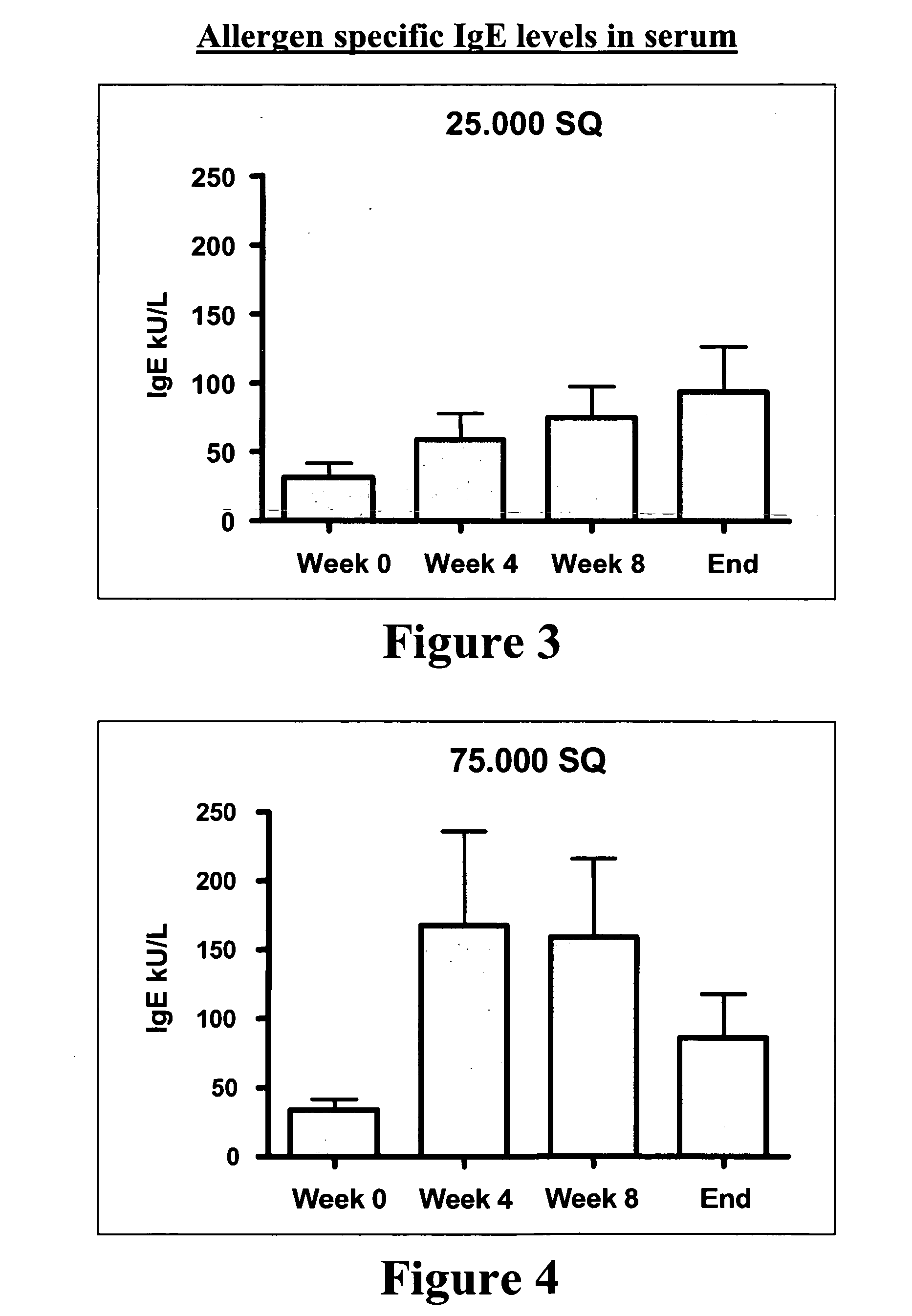Method of evaluating the therapeutic potential of a vaccine for mucosal administration
- Summary
- Abstract
- Description
- Claims
- Application Information
AI Technical Summary
Benefits of technology
Problems solved by technology
Method used
Image
Examples
example 1
Treatment of Grass Pollen Allergic Patients with Fast-Dispersing Non-Compressed Sublingual Tablets
Background
[0125] A vaccine against grass pollen allergy using an extract of Phleum pratense as allergenic active substance is known to be effective in a formulation for subcutaneous administration, wherein the allergen is formulated together with an aluminium hydroxide gel as adjuvant.
Purpose
[0126] To test the therapeutic potential (efficacy) of a new formulation of extract of Phleum pratense in the form of a fast-dispersing, non-compressed, freeze-dried tablet for sublingual administration, the tablet containing no adjuvant. The tablet contained fish gelatine as matrix forming agent. The efficacy study constitutes a part of a clinical phase I study, which also includes a safety study.
Vaccination Protocol
Test persons
[0127] 48 adult test persons between 18 and 65 years suffering from moderate to severe allergic rhinoconjunctivitis in the grass pollen season and having no sympt...
example 2
Treatment of Grass Pollen Allergic Patients with Fast-Dispersing Non-Compressed Sublingual Tablets
Background
[0155] A vaccine against grass pollen allergy using an extract of Phleum pratense as allergenic active substance is known to be effective in a formulation for subcutaneous administration, wherein the allergen is formulated together with an aluminium hydroxide gel as adjuvant.
Purpose
[0156] To test the therapeutic potential (efficacy) of a new formulation of extract of Phleum pratense in the form of a fast-dispersing, non-compressed, freeze-dried tablet for sublingual administration, the tablet containing no adjuvant. The tablet contained fish gelatine as matrix forming agent. The efficacy study constitutes a part of a clinical phase I study, which also includes a safety study.
Vaccination Protocol
Test Persons
[0157] 9 adult test persons between 18 and 65 years suffering from moderate to severe allergic rhinoconjunctivitis in the grass pollen season and having no sympto...
example 3
Treatment of Grass Pollen Allergic Patients With Fast-Dispersing Non-Compressed Sublingual Tablets
Background
[0162] A vaccine against grass pollen allergy using an extract of Phleum pratense as allergenic active substance is known to be effective in a formulation for subcutaneous administration, wherein the allergen is formulated together with an aluminium hydroxide gel as adjuvant.
Purpose
[0163] To test the therapeutic potential (efficacy) of a new formulation of extract of Phleum pratense in the form of a fast-dispersing, non-compressed, freeze-dried tablet for sublingual administration, the tablet containing no adjuvant.
[0164] The tablet contained fish gelatine as matrix forming agent. The efficacy study constitutes a part of a clinical phase IIb-III study.
Vaccination Protocol
[0165] Test Persons
[0166] 855 adult test persons between 18 and 65 years suffering from moderate to severe allergic rhinoconjunctivitis in the grass pollen season and having no symptoms outside the ...
PUM
| Property | Measurement | Unit |
|---|---|---|
| Fraction | aaaaa | aaaaa |
| Fraction | aaaaa | aaaaa |
| Fraction | aaaaa | aaaaa |
Abstract
Description
Claims
Application Information
 Login to View More
Login to View More - R&D
- Intellectual Property
- Life Sciences
- Materials
- Tech Scout
- Unparalleled Data Quality
- Higher Quality Content
- 60% Fewer Hallucinations
Browse by: Latest US Patents, China's latest patents, Technical Efficacy Thesaurus, Application Domain, Technology Topic, Popular Technical Reports.
© 2025 PatSnap. All rights reserved.Legal|Privacy policy|Modern Slavery Act Transparency Statement|Sitemap|About US| Contact US: help@patsnap.com



